Applying Ethical Theory: Cyber Security and ICT Implications
VerifiedAdded on 2023/01/17
|7
|1550
|28
Report
AI Summary
This report delves into the ethical implications of technology, particularly within the realm of cyber security. It identifies key ethical issues, such as spoofing of enterprise apps, and analyzes them through the lens of classical ethical theories including deontology, utilitarianism, virtue ethics, and contract theory. The report provides a detailed examination of each theory's relevance to cyber security threats, offering logical conclusions for resolving ethical issues and addressing moral concerns raised by the adoption and use of Information and Communication Technology (ICT). The analysis covers various aspects of cyber security, including the need for secure practices, the vulnerabilities associated with spoofing, and the importance of ethical conduct in the digital landscape. The report emphasizes the importance of making the general population aware of these malicious attacks and highlights how the application of ethical principles is crucial for protecting individuals and organizations in the cyber world.

Running head: APPLYING ETHICAL THEORY
Applying Ethical Theory
Name of the Student
Name of the University
Author Note
Applying Ethical Theory
Name of the Student
Name of the University
Author Note
Paraphrase This Document
Need a fresh take? Get an instant paraphrase of this document with our AI Paraphraser
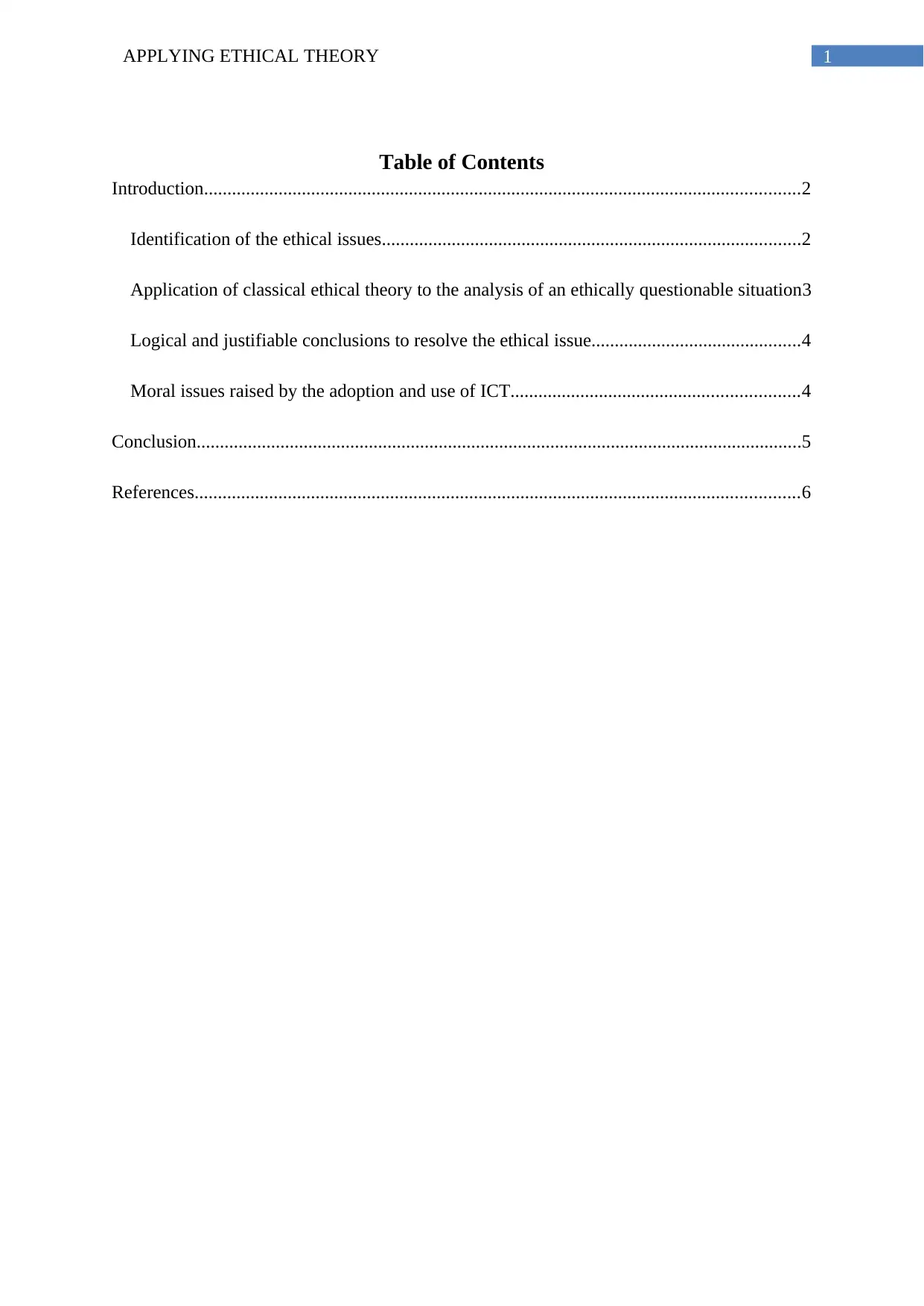
1APPLYING ETHICAL THEORY
Table of Contents
Introduction................................................................................................................................2
Identification of the ethical issues..........................................................................................2
Application of classical ethical theory to the analysis of an ethically questionable situation3
Logical and justifiable conclusions to resolve the ethical issue.............................................4
Moral issues raised by the adoption and use of ICT..............................................................4
Conclusion..................................................................................................................................5
References..................................................................................................................................6
Table of Contents
Introduction................................................................................................................................2
Identification of the ethical issues..........................................................................................2
Application of classical ethical theory to the analysis of an ethically questionable situation3
Logical and justifiable conclusions to resolve the ethical issue.............................................4
Moral issues raised by the adoption and use of ICT..............................................................4
Conclusion..................................................................................................................................5
References..................................................................................................................................6
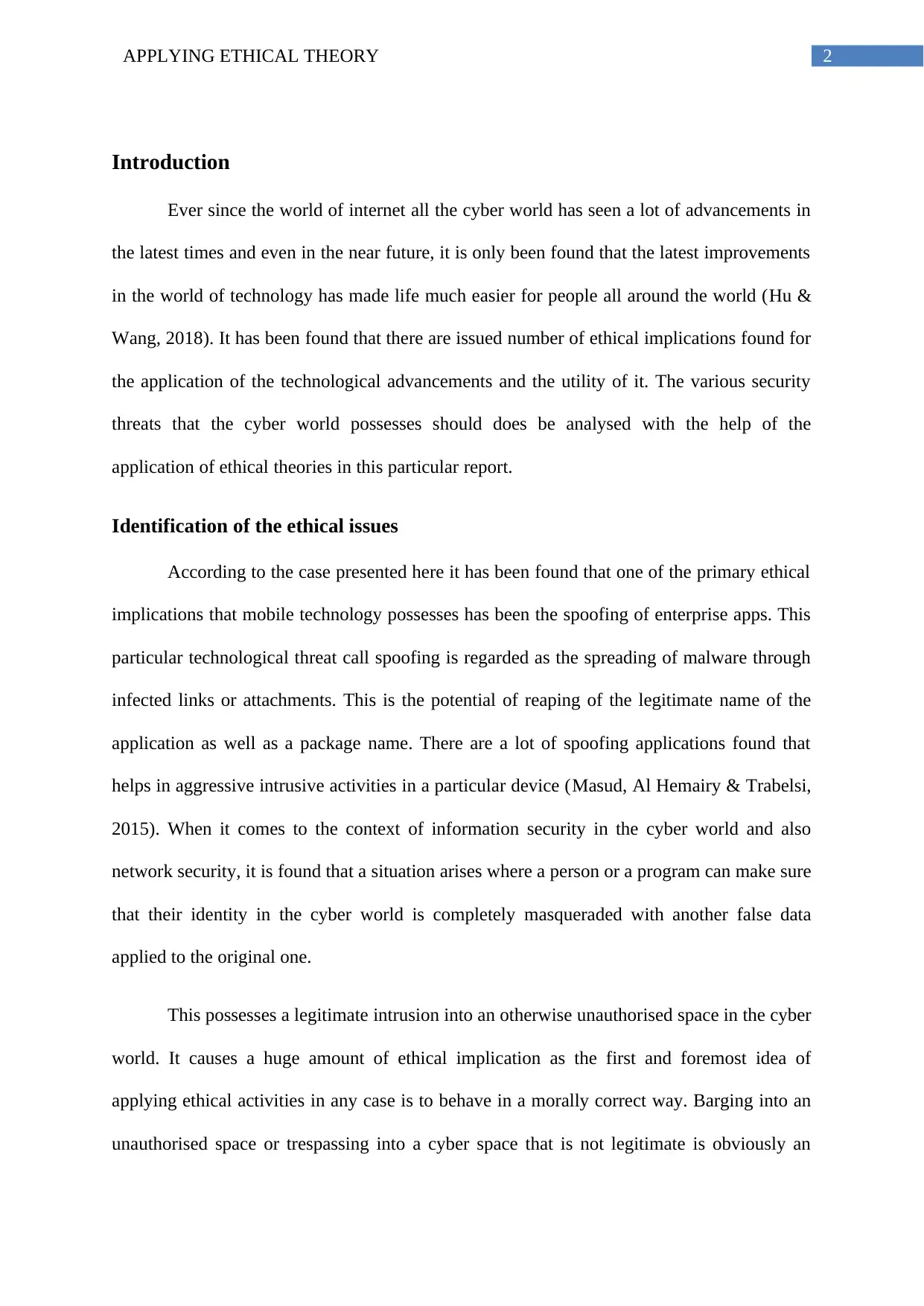
2APPLYING ETHICAL THEORY
Introduction
Ever since the world of internet all the cyber world has seen a lot of advancements in
the latest times and even in the near future, it is only been found that the latest improvements
in the world of technology has made life much easier for people all around the world (Hu &
Wang, 2018). It has been found that there are issued number of ethical implications found for
the application of the technological advancements and the utility of it. The various security
threats that the cyber world possesses should does be analysed with the help of the
application of ethical theories in this particular report.
Identification of the ethical issues
According to the case presented here it has been found that one of the primary ethical
implications that mobile technology possesses has been the spoofing of enterprise apps. This
particular technological threat call spoofing is regarded as the spreading of malware through
infected links or attachments. This is the potential of reaping of the legitimate name of the
application as well as a package name. There are a lot of spoofing applications found that
helps in aggressive intrusive activities in a particular device (Masud, Al Hemairy & Trabelsi,
2015). When it comes to the context of information security in the cyber world and also
network security, it is found that a situation arises where a person or a program can make sure
that their identity in the cyber world is completely masqueraded with another false data
applied to the original one.
This possesses a legitimate intrusion into an otherwise unauthorised space in the cyber
world. It causes a huge amount of ethical implication as the first and foremost idea of
applying ethical activities in any case is to behave in a morally correct way. Barging into an
unauthorised space or trespassing into a cyber space that is not legitimate is obviously an
Introduction
Ever since the world of internet all the cyber world has seen a lot of advancements in
the latest times and even in the near future, it is only been found that the latest improvements
in the world of technology has made life much easier for people all around the world (Hu &
Wang, 2018). It has been found that there are issued number of ethical implications found for
the application of the technological advancements and the utility of it. The various security
threats that the cyber world possesses should does be analysed with the help of the
application of ethical theories in this particular report.
Identification of the ethical issues
According to the case presented here it has been found that one of the primary ethical
implications that mobile technology possesses has been the spoofing of enterprise apps. This
particular technological threat call spoofing is regarded as the spreading of malware through
infected links or attachments. This is the potential of reaping of the legitimate name of the
application as well as a package name. There are a lot of spoofing applications found that
helps in aggressive intrusive activities in a particular device (Masud, Al Hemairy & Trabelsi,
2015). When it comes to the context of information security in the cyber world and also
network security, it is found that a situation arises where a person or a program can make sure
that their identity in the cyber world is completely masqueraded with another false data
applied to the original one.
This possesses a legitimate intrusion into an otherwise unauthorised space in the cyber
world. It causes a huge amount of ethical implication as the first and foremost idea of
applying ethical activities in any case is to behave in a morally correct way. Barging into an
unauthorised space or trespassing into a cyber space that is not legitimate is obviously an
⊘ This is a preview!⊘
Do you want full access?
Subscribe today to unlock all pages.

Trusted by 1+ million students worldwide
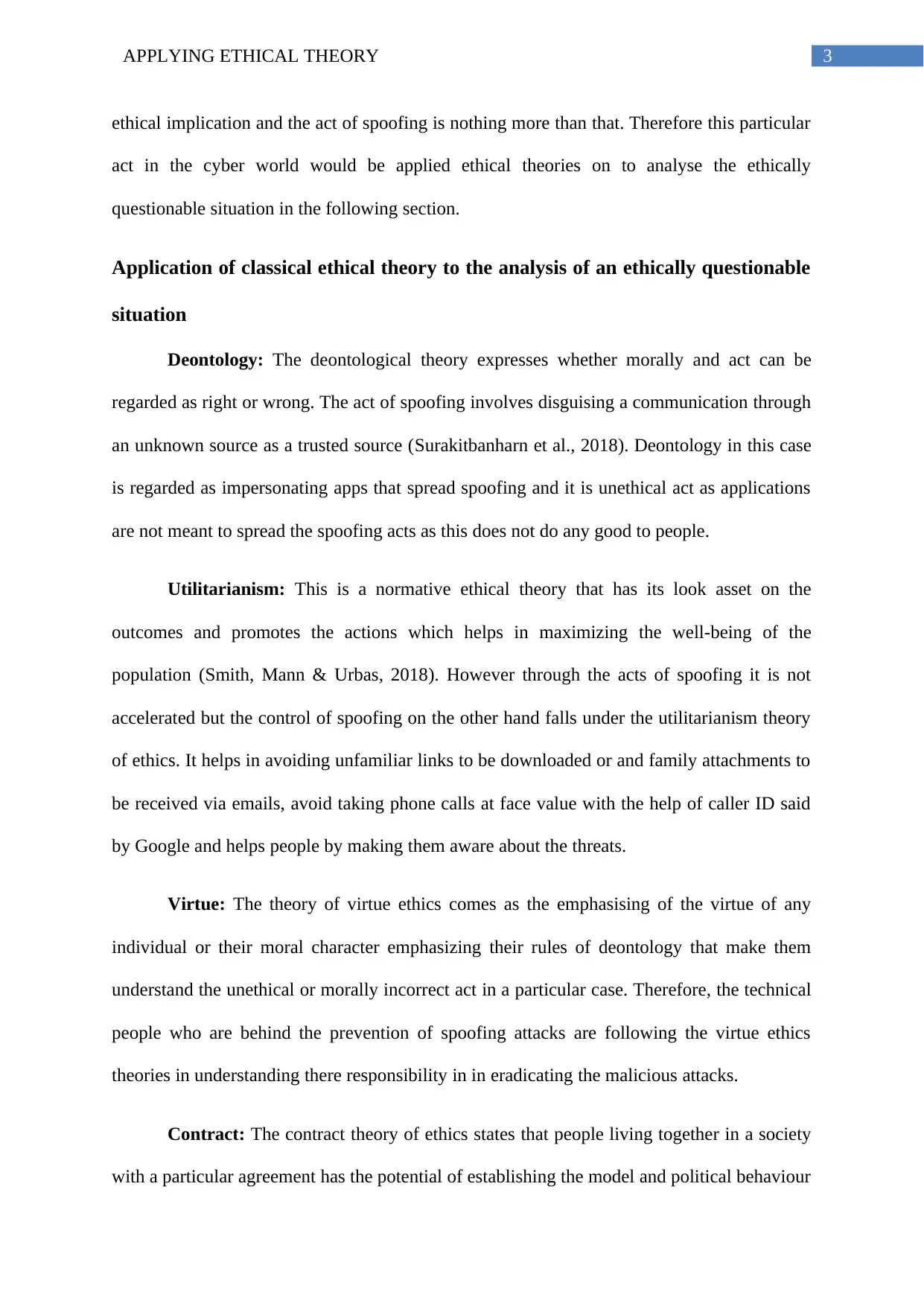
3APPLYING ETHICAL THEORY
ethical implication and the act of spoofing is nothing more than that. Therefore this particular
act in the cyber world would be applied ethical theories on to analyse the ethically
questionable situation in the following section.
Application of classical ethical theory to the analysis of an ethically questionable
situation
Deontology: The deontological theory expresses whether morally and act can be
regarded as right or wrong. The act of spoofing involves disguising a communication through
an unknown source as a trusted source (Surakitbanharn et al., 2018). Deontology in this case
is regarded as impersonating apps that spread spoofing and it is unethical act as applications
are not meant to spread the spoofing acts as this does not do any good to people.
Utilitarianism: This is a normative ethical theory that has its look asset on the
outcomes and promotes the actions which helps in maximizing the well-being of the
population (Smith, Mann & Urbas, 2018). However through the acts of spoofing it is not
accelerated but the control of spoofing on the other hand falls under the utilitarianism theory
of ethics. It helps in avoiding unfamiliar links to be downloaded or and family attachments to
be received via emails, avoid taking phone calls at face value with the help of caller ID said
by Google and helps people by making them aware about the threats.
Virtue: The theory of virtue ethics comes as the emphasising of the virtue of any
individual or their moral character emphasizing their rules of deontology that make them
understand the unethical or morally incorrect act in a particular case. Therefore, the technical
people who are behind the prevention of spoofing attacks are following the virtue ethics
theories in understanding there responsibility in in eradicating the malicious attacks.
Contract: The contract theory of ethics states that people living together in a society
with a particular agreement has the potential of establishing the model and political behaviour
ethical implication and the act of spoofing is nothing more than that. Therefore this particular
act in the cyber world would be applied ethical theories on to analyse the ethically
questionable situation in the following section.
Application of classical ethical theory to the analysis of an ethically questionable
situation
Deontology: The deontological theory expresses whether morally and act can be
regarded as right or wrong. The act of spoofing involves disguising a communication through
an unknown source as a trusted source (Surakitbanharn et al., 2018). Deontology in this case
is regarded as impersonating apps that spread spoofing and it is unethical act as applications
are not meant to spread the spoofing acts as this does not do any good to people.
Utilitarianism: This is a normative ethical theory that has its look asset on the
outcomes and promotes the actions which helps in maximizing the well-being of the
population (Smith, Mann & Urbas, 2018). However through the acts of spoofing it is not
accelerated but the control of spoofing on the other hand falls under the utilitarianism theory
of ethics. It helps in avoiding unfamiliar links to be downloaded or and family attachments to
be received via emails, avoid taking phone calls at face value with the help of caller ID said
by Google and helps people by making them aware about the threats.
Virtue: The theory of virtue ethics comes as the emphasising of the virtue of any
individual or their moral character emphasizing their rules of deontology that make them
understand the unethical or morally incorrect act in a particular case. Therefore, the technical
people who are behind the prevention of spoofing attacks are following the virtue ethics
theories in understanding there responsibility in in eradicating the malicious attacks.
Contract: The contract theory of ethics states that people living together in a society
with a particular agreement has the potential of establishing the model and political behaviour
Paraphrase This Document
Need a fresh take? Get an instant paraphrase of this document with our AI Paraphraser
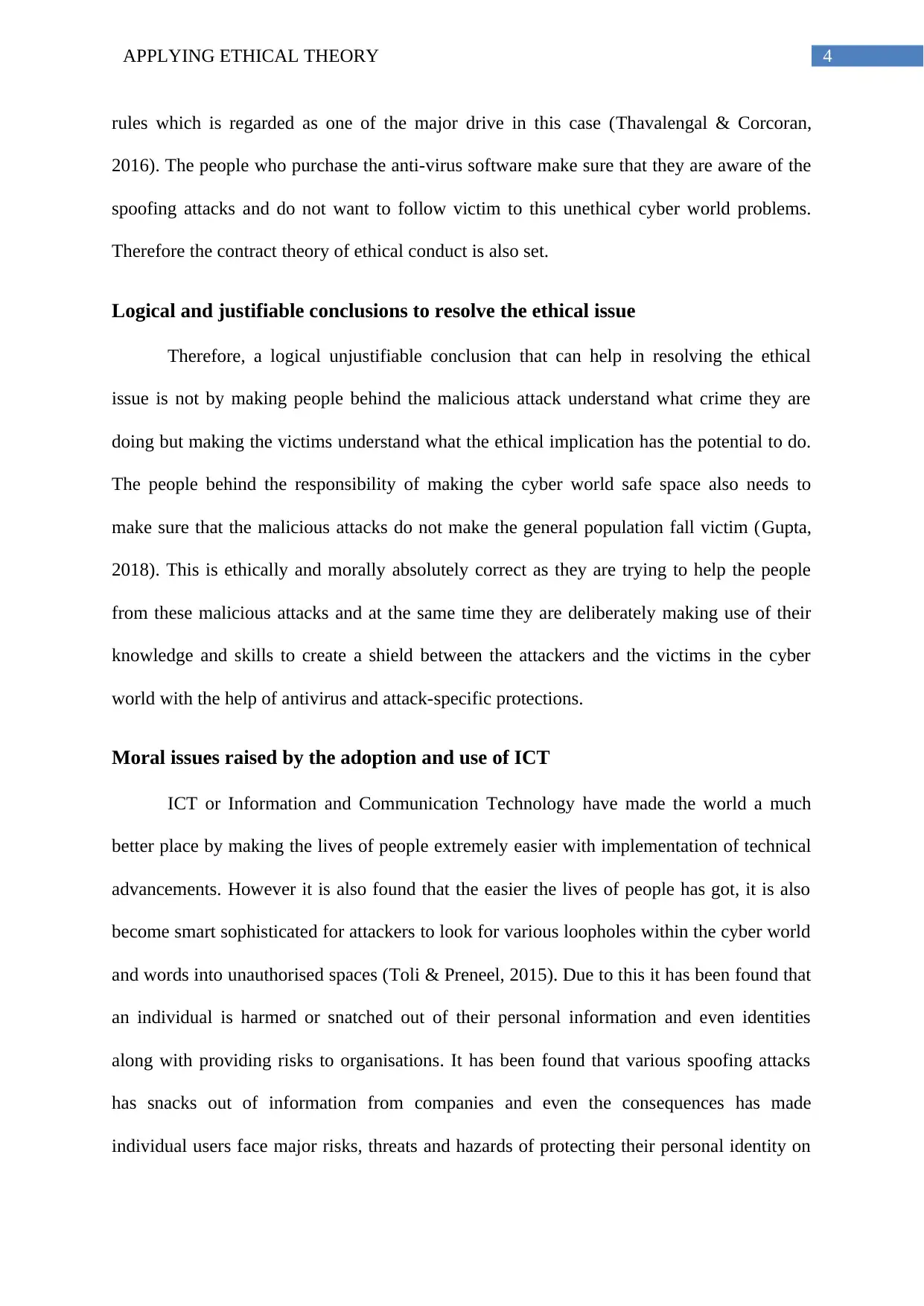
4APPLYING ETHICAL THEORY
rules which is regarded as one of the major drive in this case (Thavalengal & Corcoran,
2016). The people who purchase the anti-virus software make sure that they are aware of the
spoofing attacks and do not want to follow victim to this unethical cyber world problems.
Therefore the contract theory of ethical conduct is also set.
Logical and justifiable conclusions to resolve the ethical issue
Therefore, a logical unjustifiable conclusion that can help in resolving the ethical
issue is not by making people behind the malicious attack understand what crime they are
doing but making the victims understand what the ethical implication has the potential to do.
The people behind the responsibility of making the cyber world safe space also needs to
make sure that the malicious attacks do not make the general population fall victim (Gupta,
2018). This is ethically and morally absolutely correct as they are trying to help the people
from these malicious attacks and at the same time they are deliberately making use of their
knowledge and skills to create a shield between the attackers and the victims in the cyber
world with the help of antivirus and attack-specific protections.
Moral issues raised by the adoption and use of ICT
ICT or Information and Communication Technology have made the world a much
better place by making the lives of people extremely easier with implementation of technical
advancements. However it is also found that the easier the lives of people has got, it is also
become smart sophisticated for attackers to look for various loopholes within the cyber world
and words into unauthorised spaces (Toli & Preneel, 2015). Due to this it has been found that
an individual is harmed or snatched out of their personal information and even identities
along with providing risks to organisations. It has been found that various spoofing attacks
has snacks out of information from companies and even the consequences has made
individual users face major risks, threats and hazards of protecting their personal identity on
rules which is regarded as one of the major drive in this case (Thavalengal & Corcoran,
2016). The people who purchase the anti-virus software make sure that they are aware of the
spoofing attacks and do not want to follow victim to this unethical cyber world problems.
Therefore the contract theory of ethical conduct is also set.
Logical and justifiable conclusions to resolve the ethical issue
Therefore, a logical unjustifiable conclusion that can help in resolving the ethical
issue is not by making people behind the malicious attack understand what crime they are
doing but making the victims understand what the ethical implication has the potential to do.
The people behind the responsibility of making the cyber world safe space also needs to
make sure that the malicious attacks do not make the general population fall victim (Gupta,
2018). This is ethically and morally absolutely correct as they are trying to help the people
from these malicious attacks and at the same time they are deliberately making use of their
knowledge and skills to create a shield between the attackers and the victims in the cyber
world with the help of antivirus and attack-specific protections.
Moral issues raised by the adoption and use of ICT
ICT or Information and Communication Technology have made the world a much
better place by making the lives of people extremely easier with implementation of technical
advancements. However it is also found that the easier the lives of people has got, it is also
become smart sophisticated for attackers to look for various loopholes within the cyber world
and words into unauthorised spaces (Toli & Preneel, 2015). Due to this it has been found that
an individual is harmed or snatched out of their personal information and even identities
along with providing risks to organisations. It has been found that various spoofing attacks
has snacks out of information from companies and even the consequences has made
individual users face major risks, threats and hazards of protecting their personal identity on
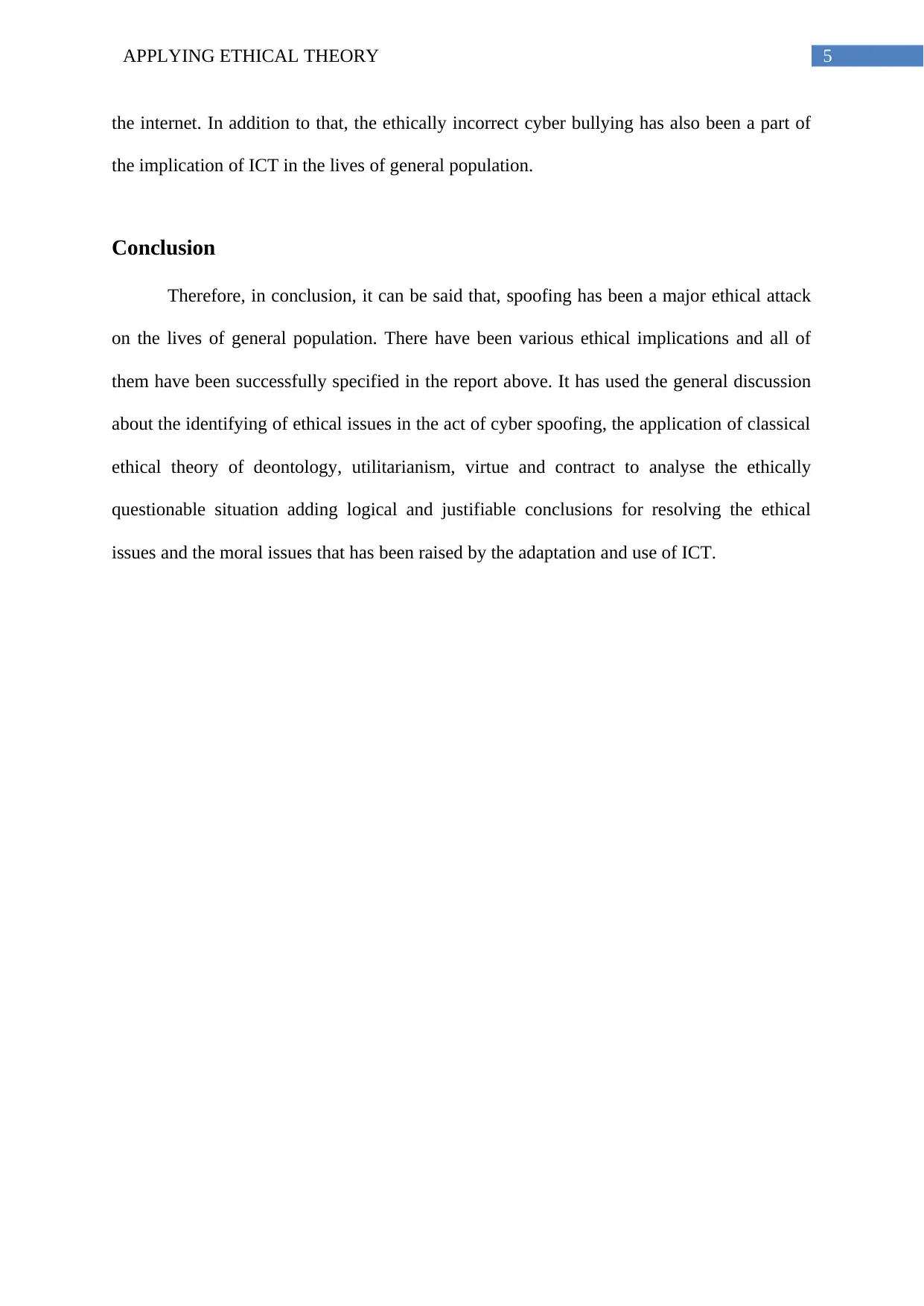
5APPLYING ETHICAL THEORY
the internet. In addition to that, the ethically incorrect cyber bullying has also been a part of
the implication of ICT in the lives of general population.
Conclusion
Therefore, in conclusion, it can be said that, spoofing has been a major ethical attack
on the lives of general population. There have been various ethical implications and all of
them have been successfully specified in the report above. It has used the general discussion
about the identifying of ethical issues in the act of cyber spoofing, the application of classical
ethical theory of deontology, utilitarianism, virtue and contract to analyse the ethically
questionable situation adding logical and justifiable conclusions for resolving the ethical
issues and the moral issues that has been raised by the adaptation and use of ICT.
the internet. In addition to that, the ethically incorrect cyber bullying has also been a part of
the implication of ICT in the lives of general population.
Conclusion
Therefore, in conclusion, it can be said that, spoofing has been a major ethical attack
on the lives of general population. There have been various ethical implications and all of
them have been successfully specified in the report above. It has used the general discussion
about the identifying of ethical issues in the act of cyber spoofing, the application of classical
ethical theory of deontology, utilitarianism, virtue and contract to analyse the ethically
questionable situation adding logical and justifiable conclusions for resolving the ethical
issues and the moral issues that has been raised by the adaptation and use of ICT.
⊘ This is a preview!⊘
Do you want full access?
Subscribe today to unlock all pages.

Trusted by 1+ million students worldwide
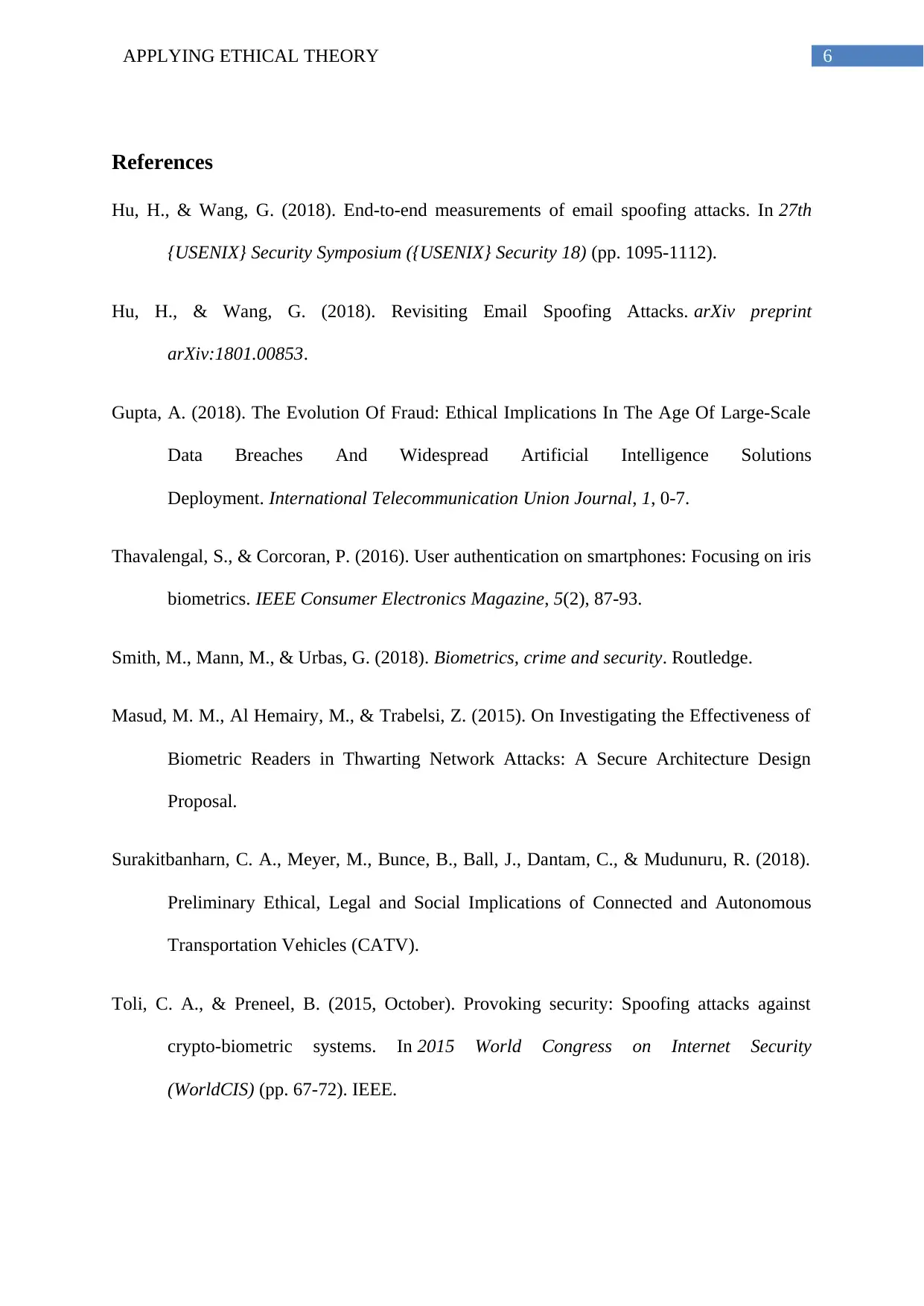
6APPLYING ETHICAL THEORY
References
Hu, H., & Wang, G. (2018). End-to-end measurements of email spoofing attacks. In 27th
{USENIX} Security Symposium ({USENIX} Security 18) (pp. 1095-1112).
Hu, H., & Wang, G. (2018). Revisiting Email Spoofing Attacks. arXiv preprint
arXiv:1801.00853.
Gupta, A. (2018). The Evolution Of Fraud: Ethical Implications In The Age Of Large-Scale
Data Breaches And Widespread Artificial Intelligence Solutions
Deployment. International Telecommunication Union Journal, 1, 0-7.
Thavalengal, S., & Corcoran, P. (2016). User authentication on smartphones: Focusing on iris
biometrics. IEEE Consumer Electronics Magazine, 5(2), 87-93.
Smith, M., Mann, M., & Urbas, G. (2018). Biometrics, crime and security. Routledge.
Masud, M. M., Al Hemairy, M., & Trabelsi, Z. (2015). On Investigating the Effectiveness of
Biometric Readers in Thwarting Network Attacks: A Secure Architecture Design
Proposal.
Surakitbanharn, C. A., Meyer, M., Bunce, B., Ball, J., Dantam, C., & Mudunuru, R. (2018).
Preliminary Ethical, Legal and Social Implications of Connected and Autonomous
Transportation Vehicles (CATV).
Toli, C. A., & Preneel, B. (2015, October). Provoking security: Spoofing attacks against
crypto-biometric systems. In 2015 World Congress on Internet Security
(WorldCIS) (pp. 67-72). IEEE.
References
Hu, H., & Wang, G. (2018). End-to-end measurements of email spoofing attacks. In 27th
{USENIX} Security Symposium ({USENIX} Security 18) (pp. 1095-1112).
Hu, H., & Wang, G. (2018). Revisiting Email Spoofing Attacks. arXiv preprint
arXiv:1801.00853.
Gupta, A. (2018). The Evolution Of Fraud: Ethical Implications In The Age Of Large-Scale
Data Breaches And Widespread Artificial Intelligence Solutions
Deployment. International Telecommunication Union Journal, 1, 0-7.
Thavalengal, S., & Corcoran, P. (2016). User authentication on smartphones: Focusing on iris
biometrics. IEEE Consumer Electronics Magazine, 5(2), 87-93.
Smith, M., Mann, M., & Urbas, G. (2018). Biometrics, crime and security. Routledge.
Masud, M. M., Al Hemairy, M., & Trabelsi, Z. (2015). On Investigating the Effectiveness of
Biometric Readers in Thwarting Network Attacks: A Secure Architecture Design
Proposal.
Surakitbanharn, C. A., Meyer, M., Bunce, B., Ball, J., Dantam, C., & Mudunuru, R. (2018).
Preliminary Ethical, Legal and Social Implications of Connected and Autonomous
Transportation Vehicles (CATV).
Toli, C. A., & Preneel, B. (2015, October). Provoking security: Spoofing attacks against
crypto-biometric systems. In 2015 World Congress on Internet Security
(WorldCIS) (pp. 67-72). IEEE.
1 out of 7
Related Documents
Your All-in-One AI-Powered Toolkit for Academic Success.
+13062052269
info@desklib.com
Available 24*7 on WhatsApp / Email
![[object Object]](/_next/static/media/star-bottom.7253800d.svg)
Unlock your academic potential
Copyright © 2020–2025 A2Z Services. All Rights Reserved. Developed and managed by ZUCOL.





